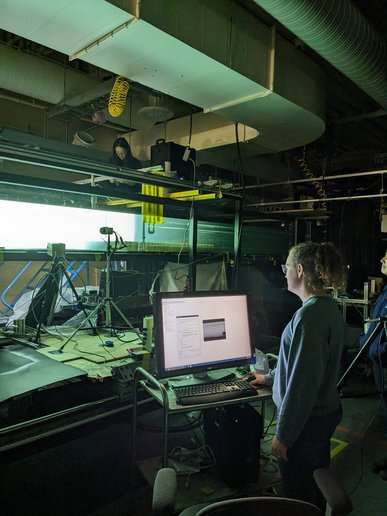This article has been reviewed according to Science X's editorial process and policies. Editors have highlighted the following attributes while ensuring the content's credibility:
fact-checked
trusted source
proofread
Better predictions of wildfire spread may sit above the treetops

When the skies above Palo Alto darkened with smoke from the Camp Fire in 2018, Stanford researcher Hayoon Chung was in a fluid mechanics lab on campus studying how ocean currents flowed over patches of seagrass. She wondered if patterns similar to the ones she observed in her lab experiments might exist in the rapid and seemingly random spread of the nearby wildfires.
Chung knocked on the door of her advisor, civil and environmental engineering Professor Jeffrey Koseff. Together, they hashed out a plan to pivot their project's focus from ocean currents to investigate how wildfire plumes morph and flow over forest canopies. Until then, wildfire models had never captured how treetop height and spacing might influence wind currents.
"I wanted to show that the physics that I'm interested in matters in wildfires. And I want to help people who are trying to model the spread of wildfires understand which physics to incorporate," said Chung, who is a postdoctoral scholar in civil and environmental engineering, a department in the Stanford Doerr School of Sustainability and Stanford Engineering.
In the lab, Koseff and Chung discovered that indeed, the length and overall size of a forest canopy strongly influences the behavior of fire plumes—the hot, turbulent air that rushes up and out from a flame and can launch embers into flight. Their research, published June 23 in the journal Physical Review Fluids, shows that a forest canopy creates its own wind currents and turbulence, and that wildfire behavior can shift depending on a canopy's dimensions.
The scholars are now building upon this research to help inform efforts to mitigate "spot fires" ignited by flying embers, an increasingly common route of wildfire spread responsible for many if not most of the fires that end up destroying homes during wildfires.
The physics of flying embers
Because embers lofted by fire plumes and carried on the wind can land miles away from the main fire front, traditional fire management tactics such as cutting firebreaks and thinning don't work against spot fires, and the factors that influence where embers will fly are not well understood.
To help address this problem, Koseff and Chung teamed up with civil and environmental engineering Professor Nicholas Oullette and Ph.D. students Erika MacDonald and Laura Sunberg. They secured a seed grant from the Stanford Institute for Human-Centered Artificial Intelligence (HAI) in 2022 to examine how physical features such as forest structure, wind speed, and flame intensity influence firebrand trajectories, and set out to provide future AI-driven models of spot-fire spread with information about the underlying physical dynamics.
"By understanding more and more of the physics behind these flying embers, we can remove some of the uncertainty in predictions," said Koseff. "It's not to say we'll have a perfect prediction. But by doing the kinds of experiments that we're doing, you can then start getting a better sense of what is likely to happen."
The team's fire simulations take place in an unlikely space: a 30-foot-long, 4-foot-wide flume of 3-foot deep water. Although the flume is more often used to model the physics of fluids tumbling through aquatic environments, it has also allowed the Stanford team to visualize the fluid-like streams of heated air that rush upward from flames and interact with cooler airflows in the atmosphere.
To simulate a forest canopy, the scientists arrange simple wooden dowels in a repeatable pattern. They send water flowing over the dowels to simulate air flowing over the canopy. Next, they turn on a jet of very hot water at the top of the dowels and observe how this "plume" interacts with the flow over the canopy and responds to bigger or smaller gaps between the dowels.
As a finishing touch, Sunberg, who has studied how microplastics disperse in the ocean, adds in tiny plastic spheres and rods that behave like embers in the flume. She observes how the hot-water jet lifts and pushes the plastic pieces away from the dowels and where they land in the tank. "We're trying to tease apart the different physics that are present and ask, 'Does it matter if the forest canopy is really long upstream,' and we find that it does. 'Does it matter if there's a hot plume?' Yes, it does," Sunberg said.
The researchers are focusing their experiments on the canopy structure because, unlike wind and terrain, wildfire managers have some control over it through fuel management practices, such as prescribed burns or simply cutting down trees.
Firefighters often cut down a strip of trees to get into a forest as quickly and safely as possible when they're fighting wildfires. But these cuts may unintentionally affect wind flow and turbulence in a way that exacerbates the spot-fire challenge.
"The data we are generating is critically important for any kind of predictive scheme that wildfire managers might want to develop," said Koseff, who is also a senior fellow at the Stanford Woods Institute for the Environment. "Our data incorporates what we think are the important physics of the elements interacting with one another: flow over the canopy, having the presence of a hot plume from a fire, and then the canopy gaps."
Ultimately, the Stanford team hopes to connect with more modelers at Cal Fire, the U.S. Forest Service, and other wildfire management agencies. "With their input, we can conduct more experiments reflective of the needs they have in the field to prevent the real destruction coming from these spot fires and these burning embers."
More information: Hayoon Chung et al, Interaction of a buoyant plume with a turbulent canopy mixing layer, Physical Review Fluids (2023). DOI: 10.1103/PhysRevFluids.8.064501
Provided by Stanford University





















